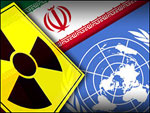 Reuters: A U.N. nuclear agency report due this week is expected to show Iran further increasing its capacity to produce material that its adversaries fear could eventually be put to developing atomic bombs, Western diplomats said on Tuesday. By Fredrik Dahl
Reuters: A U.N. nuclear agency report due this week is expected to show Iran further increasing its capacity to produce material that its adversaries fear could eventually be put to developing atomic bombs, Western diplomats said on Tuesday. By Fredrik Dahl
 VIENNA (Reuters) – A U.N. nuclear agency report due this week is expected to show Iran further increasing its capacity to produce material that its adversaries fear could eventually be put to developing atomic bombs, Western diplomats said on Tuesday.
VIENNA (Reuters) – A U.N. nuclear agency report due this week is expected to show Iran further increasing its capacity to produce material that its adversaries fear could eventually be put to developing atomic bombs, Western diplomats said on Tuesday.
But they said it is also likely to indicate that growth in Iran’s most sensitive nuclear stockpile has been held back because some of it has been used for reactor fuel, potentially providing more time for diplomacy between Iran and major powers.
Tehran’s holding of medium-enriched uranium gas is closely watched in the West as Israel – which has threatened air strikes if diplomacy and sanctions do not stop Iran’s atomic drive – says it must not amass enough for one bomb if further processed.
Critics say Iran is trying to achieve the capability to make atomic arms. Iran denies this, saying it needs nuclear power for energy generation and medical purposes and that it is Israel’s reputed nuclear arsenal that threatens regional peace.
The next quarterly report on Iran’s nuclear program by the U.N. International Atomic Energy Agency (IAEA), expected on Wednesday, is likely to show continued installation of the centrifuges used for enriching uranium, diplomats said.
That would include an advanced model known as IR-2m which, once operational, would enable Iran to speed up sharply its accumulation of refined uranium, which can have both civilian and military purposes.
The number of IR-2m centrifuges and empty centrifuge casings that have been put in place at Iran’s main enrichment site near the town of Natanz is expected to have risen significantly since February, when it stood at 180, they said.
Iran has for years been trying to develop centrifuges more efficient than the erratic 1970s-vintage IR-1 machines it now uses, but introducing new models has been dogged by technical hurdles and difficulty in obtaining key parts abroad.
“We expect that they’ve continued to install more advanced centrifuges at Natanz,” one diplomat said.
Another Western envoy said Iran was also believed to be pressing ahead in the construction of a research reactor, which experts say could offer it a second way of producing material for a nuclear bomb, if it decided to embark on such a course.
Nuclear analysts say the type of reactor that Iran is building near the town of Arak could yield plutonium for nuclear arms if the spent fuel is reprocessed, something Iran has said it has no intention of doing.
NUCLEAR STOCKPILE
Diplomats will also scrutinise the IAEA report for what it has to say about Iran’s possession of medium-enriched uranium as this represents a technical threshold relatively close to the level required for nuclear bombs.
Since Iran in 2010 began processing uranium to a fissile concentration of 20 percent it has produced more than the 240-250 kg that would be needed for one bomb, if refined more.
But while the stockpile has expanded, Iran has still kept it below Israel’s stated “red line” by converting a large part of the uranium gas into oxide powder in order, Tehran says, to yield fuel for a medical research reactor in the capital.
As a result, the increase in the holding of 20 percent gas has been less than the production. In February, the stockpile was 167 kg, a rise of roughly 18-19 kg since the previous report in December but a significant slowdown from a 50 percent jump in the previous three-month period.
“It seems that they are converting nearly all the material that they are producing,” a Western official said.
But while the uranium conversion activity may postpone any decision by Israel on whether to strike Iranian nuclear sites, Western diplomats made clear Tehran must do much more in order to allay suspicions about its atomic program.
Turning uranium gas into oxide powder in order to make fuel plates may also be just a temporary positive development because the process is possible to reverse, Western experts say.
The six world powers involved in diplomacy with Iran – the United States, Russia, France, Britain, Germany and China – want it to stop refining uranium to 20 percent and suspend work at the underground Fordow site where most of this work is pursued.
(For an interactive timeline on Iran’s nuclear program, click on link.reuters.com/gad76r )
(Editing by Mark Heinrich)


